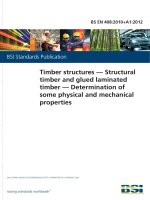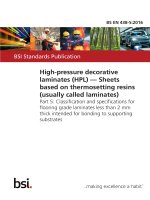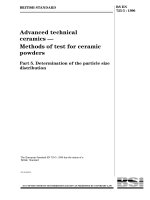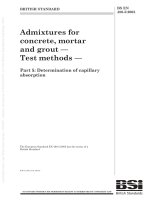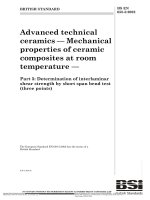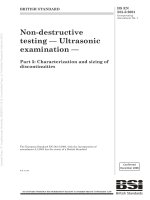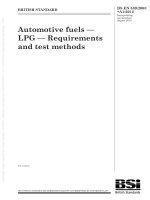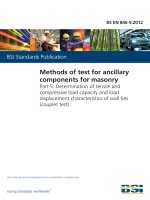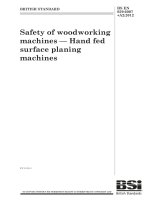Bsi bs en 61784 5 3 2012
Bạn đang xem bản rút gọn của tài liệu. Xem và tải ngay bản đầy đủ của tài liệu tại đây (1.83 MB, 108 trang )
Licensed copy: Vocational Trading Council, Vocational Training Council, Version correct as of 30/08/2012 23:22, (c) The British Standards Institution 2012
BS EN 61784-5-3:2012
BSI Standards Publication
Industrial communication
networks — Profiles
Part 5-3: Installation of fieldbuses —
Installation profiles for CPF 3
NO COPYING WITHOUT BSI PERMISSION EXCEPT AS PERMITTED BY COPYRIGHT LAW
raising standards worldwide™
BRITISH STANDARD
Licensed copy: Vocational Trading Council, Vocational Training Council, Version correct as of 30/08/2012 23:22, (c) The British Standards Institution 2012
BS EN 61784-5-3:2012
National foreword
This British Standard is the UK implementation of EN 61784-5-3:2012.
It is identical to IEC 61784-5-3:2010. It supersedes BS EN 61784-5-3:2008,
which is withdrawn.
The UK participation in its preparation was entrusted to Technical
Committee AMT/7, Industrial communications: process measurement
and control, including fieldbus.
A list of organizations represented on this committee can be obtained
on request to its secretary.
This publication does not purport to include all the necessary provisions of
a contract. Users are responsible for its correct application.
© The British Standards Institution 2012
Published by BSI Standards Limited 2012
ISBN 978 0 580 72456 5
ICS 25.040.40; 35.100.40
Compliance with a British Standard cannot confer immunity from
legal obligations.
This British Standard was published under the authority of the
Standards Policy and Strategy Committee on 31 May 2012.
Amendments issued since publication
Date
Text affected
BS EN 61784-5-3:2012
Licensed copy: Vocational Trading Council, Vocational Training Council, Version correct as of 30/08/2012 23:22, (c) The British Standards Institution 2012
EUROPEAN STANDARD
EN 61784-5-3
NORME EUROPÉENNE
April 2012
EUROPÄISCHE NORM
ICS 25.040.40; 35.100.40
Supersedes EN 61784-5-3:2008
English version
Industrial communication networks Profiles Part 5-3: Installation of fieldbuses Installation profiles for CPF 3
(IEC 61784-5-3:2010)
Réseaux de communication industriels Profils Partie 5-3: Installation des bus de terrain Profils d'installation pour CPF 3
(CEI 61784-5-3:2010)
Industrielle Kommunikationsnetze Profile Teil 5-3: Feldbusinstallation Installationsprofile für die
Kommunikationsprofilfamilie 3
(IEC 61784-5-3:2010)
This European Standard was approved by CENELEC on 2011-10-19. CENELEC members are bound to comply
with the CEN/CENELEC Internal Regulations which stipulate the conditions for giving this European Standard
the status of a national standard without any alteration.
Up-to-date lists and bibliographical references concerning such national standards may be obtained on
application to the CEN-CENELEC Management Centre or to any CENELEC member.
This European Standard exists in three official versions (English, French, German). A version in any other
language made by translation under the responsibility of a CENELEC member into its own language and notified
to the CEN-CENELEC Management Centre has the same status as the official versions.
CENELEC members are the national electrotechnical committees of Austria, Belgium, Bulgaria, Croatia, Cyprus,
the Czech Republic, Denmark, Estonia, Finland, France, Germany, Greece, Hungary, Iceland, Ireland, Italy,
Latvia, Lithuania, Luxembourg, Malta, the Netherlands, Norway, Poland, Portugal, Romania, Slovakia, Slovenia,
Spain, Sweden, Switzerland, Turkey and the United Kingdom.
CENELEC
European Committee for Electrotechnical Standardization
Comité Européen de Normalisation Electrotechnique
Europäisches Komitee für Elektrotechnische Normung
Management Centre: Avenue Marnix 17, B - 1000 Brussels
© 2012 CENELEC -
All rights of exploitation in any form and by any means reserved worldwide for CENELEC members.
Ref. No. EN 61784-5-3:2012 E
Licensed copy: Vocational Trading Council, Vocational Training Council, Version correct as of 30/08/2012 23:22, (c) The British Standards Institution 2012
BS EN 61784-5-3:2012
EN 61784-5-3:2012
-2-
Foreword
The text of document 65C/602/FDIS, future edition 2 of IEC 61784-5-3, prepared by SC 65C, "Industrial
networks", of IEC/TC 65, "Industrial-process measurement, control and automation" was submitted to the
IEC-CENELEC parallel vote and approved by CENELEC as EN 61784-5-3:2012.
The following dates are fixed:
•
•
latest date by which the document has
to be implemented at national level by
publication of an identical national
standard or by endorsement
latest date by which the national
standards conflicting with the
document have to be withdrawn
(dop)
2012-10-20
(dow)
2014-10-19
This document supersedes EN 61784-5-3:2008.
EN 61784-5-3:2012 includes an addition concerning transmission performance measurement (see
C.6.3.2.1.2).
This standard is to be used in conjunction with IEC 61918, second edition (2010-07), together with the
European Common Modification published with EN 61918:2008.
Attention is drawn to the possibility that some of the elements of this document may be the subject of
patent rights. CENELEC [and/or CEN] shall not be held responsible for identifying any or all such patent
rights.
Endorsement notice
The text of the International Standard IEC 61784-5-3:2010 was approved by CENELEC as a European
Standard without any modification.
BS EN 61784-5-3:2012
EN 61784-5-3:2012
Licensed copy: Vocational Trading Council, Vocational Training Council, Version correct as of 30/08/2012 23:22, (c) The British Standards Institution 2012
-3-
Annex ZA
(normative)
Normative references to international publications
with their corresponding European publications
The following referenced documents are indispensable for the application of this document. For dated
references, only the edition cited applies. For undated references, the latest edition of the referenced
document (including any amendments) applies.
NOTE When an international publication has been modified by common modifications, indicated by (mod), the relevant EN/HD
applies.
Publication
Year
Title
EN/HD
Year
-
-
Electrical apparatus for potentially explosive
atmospheres - Intrinsic safety 'i'
EN 50020
-
IEC 60079-0
+ corr. December
2007
2010
Explosive atmospheres Part 0: Equipment - General requirements
EN 60079-0
2009
IEC 60079-11
+ corr. December
2006
2006
Explosive atmospheres Part 11: Equipment protection by intrinsic
safety "i"
EN 60079-11
2007
IEC 60079-27
2008
Explosive atmospheres Part 27: Fieldbus intrinsically safe concept
(FISCO)
EN 60079-27
2008
IEC 60512-6-3
-
Connectors for electronic equipment - Tests
and measurements Part 6-3: Dynamic stress tests - Test 6c:
Shock
EN 60512-6-3
-
IEC 60512-6-4
-
Connectors for electronic equipment - Tests
and measurements Part 6-4: Dynamic stress tests - Test 6d:
Vibration (sinusoidal)
EN 60512-6-4
-
IEC 60793-2-10
2007
Optical fibres EN 60793-2-10
Part 2-10: Product specifications - Sectional
specification for category A1 multimode fibres
2007
IEC 60793-2-50
2008
Optical fibres Part 2-50: Product specifications - Sectional
specification for class B single-mode fibres
2008
IEC 61000-4-2
2008
EN 61000-4-2
Electromagnetic compatibility (EMC) Part 4-2: Testing and measurement
techniques - Electrostatic discharge immunity
test
2009
IEC 61076-2-107
2010
Connectors for electronic equipment - Product EN 61076-2-107
requirements Part 2-107: Detail specification for circular
hybrid connectors M12 with electrical and
fibre-optic contacts with screw-locking
2010
IEC 61156-5
+ corr. May
+ corr. February
2009
2009
2010
Multicore and symmetrical pair/quad cables for digital communications Part 5: Symmetrical pair/quad cables with
transmission characteristics up to 1 000 MHz Horizontal floor wiring - Sectional specification
-
1)
1)
EN 60793-2-50
EN 60793-2-10 is superseded by EN 60793-2-10:2011, which is based on IEC 60793-2-10:2011.
Licensed copy: Vocational Trading Council, Vocational Training Council, Version correct as of 30/08/2012 23:22, (c) The British Standards Institution 2012
BS EN 61784-5-3:2012
EN 61784-5-3:2012
-4-
Publication
Year
IEC 61508
Series Functional safety of
EN 61508
electrical/electronic/programmable electronic
safety-related systems
IEC 61754-24-11
-
Fibre optic interconnecting devices and
passive components - Fibre optic connector
interfaces Part 24-11: Type SC-RJ connectors with
protective housings based on
IEC 61076-3-117
EN 61754-24-11
-
IEC 61918
2010
Industrial communication networks Installation of communication networks in
industrial premises
-
-
Electrical Characteristics of Generators and
Receivers for Use in Balanced Digital
Multipoint Systems
-
-
ANSI TIA/EIA-485-A -
Title
EN/HD
Year
Series
Licensed copy: Vocational Trading Council, Vocational Training Council, Version correct as of 30/08/2012 23:22, (c) The British Standards Institution 2012
–2–
BS EN 61784-5-3:2012
61784-5-3 © IEC:2010(E)
CONTENTS
INTRODUCTION.....................................................................................................................7
1
Scope ...............................................................................................................................8
2
Normative references .......................................................................................................8
3
Terms, definitions and abbreviated terms .........................................................................8
4
CPF 3: Overview of installation profiles ............................................................................8
5
Installation profile conventions .........................................................................................9
6
Conformance to installation profiles ..................................................................................9
Annex A (normative) CP 3/1 (PROFIBUS) specific installation profile................................... 11
Annex B (normative)
CP 3/2 (PROFIBUS) specific installation profile.................................. 43
Annex C (normative) CP 3/3, CP 3/4, CP 3/5, CP 3/6 (PROFINET) specific installation
profile ................................................................................................................................... 77
Bibliography........................................................................................................................ 103
Figure 1 – Standards relationships..........................................................................................7
Figure A.1 – Recommended combination of shielding and earthing for CP 3/1
networks with RS 485-IS ....................................................................................................... 24
Figure A.2 – Sub-D connector pin numberings (front view).................................................... 29
Figure A.3 – 5-pin M-12 female socket .................................................................................. 30
Figure A.4 – 5 pins M-12 male plug for CP 3/1 ...................................................................... 31
Figure A.5 – Test circuit A - resistance measurement of data line B and shield ..................... 36
Figure A.6 – Test circuit B - resistance measurement of data line A and shield ..................... 37
Figure A.7 – Test circuit C - resistance measurement of data line A, data line B, and
shield.................................................................................................................................... 37
Figure A.8 – Test circuit D - resistance measurement between data line A and B ................. 38
Figure A.9 – Resistance measurement without 9-pin Sub-D plug .......................................... 38
Figure A.10 – Loop core resistance (cable type A) ................................................................ 39
Figure A.11 – Action and resolution tree for measurement 1 (RS 485 and RS 485-IS) .......... 40
Figure A.12 – Action and resolution tree for measurement 2 (RS 485 and RS 485-IS) .......... 41
Figure A.13 – Action and resolution tree for measurement 3 (RS 485 and RS 485-IS) .......... 41
Figure B.1 – Connection of CP 3/1 networks ......................................................................... 46
Figure B.2 – Typical fieldbus architecture ............................................................................. 48
Figure B.3 – Fieldbus with stations supplied by auxiliary power sources ............................... 49
Figure B.4 – Fieldbus model ................................................................................................. 51
Figure B.5 – Current modulation (Manchester II code) .......................................................... 52
Figure B.6 – Tree topology ................................................................................................... 53
Figure B.7 – Bus topology ..................................................................................................... 54
Figure B.8 – Combination of the tree topology and the bus topology ..................................... 54
Figure B.9 – Fieldbus extension ............................................................................................ 55
Figure B.10 – Recommended combination of shielding and earthing ..................................... 67
Figure B.11 – Ideal combination of shielding and earthing .................................................... 69
Figure B.12 – Capacitive earthing ......................................................................................... 70
Figure B.13 – Galvanic isolated field device .......................................................................... 71
Licensed copy: Vocational Trading Council, Vocational Training Council, Version correct as of 30/08/2012 23:22, (c) The British Standards Institution 2012
BS EN 61784-5-3:2012
61784-5-3 © IEC:2010(E)
–3–
Figure B.14 – Pin assignment of the male and female connectors IEC 60947-5-2 (Acoding) ................................................................................................................................. 74
Figure C.1 – End-to-end link without interconnections........................................................... 90
Figure C.2 – Assembled end-to-end link ............................................................................... 90
Figure C.3 – Connectionless optical fibre link ....................................................................... 91
Figure C.4 – Assembled optical fibre link .............................................................................. 91
Figure C.5 – Shielded connectors for CP 3/3, CP 3/4, CP 3/5 and CP 3/6 fieldbus
networks ............................................................................................................................... 97
Figure C.6 – Pin-assignment for a straight cable ................................................................... 97
Table A.1 – Excerpt of MICE definition.................................................................................. 13
Table A.2 – Basic network characteristics for balanced cabling not based on Ethernet
(ISO/IEC 8802-3) .................................................................................................................. 15
Table A.3 – Network characteristics for optical fibre cabling.................................................. 15
Table A.4 – Information relevant to copper cable: fixed cables .............................................. 17
Table A.5 – Information relevant to optical fibre cables ......................................................... 18
Table A.6 – Connectors for copper cabling CPs not based on Ethernet ................................. 19
Table A.7 – Optical fibre connecting hardware ...................................................................... 19
Table A.8 – Relationship between FOC and fibre types (CP 3/1)........................................... 20
Table A.9 – Parameters for balanced cables ......................................................................... 26
Table A.10 – Parameters for silica optical fibre cables .......................................................... 27
Table A.11 – Parameters for POF optical fibre cables ........................................................... 27
Table A.12 – Parameters for hard clad silica optical fibre cables ........................................... 27
Table A.13 – Use of 9 pin Sub-D connector pins (RS 485) .................................................... 29
Table A.14 – Use of 9 pin Sub-D connector pins (RS 485-IS)................................................ 30
Table A.15 – Use of M12 connector pins (RS 485) ................................................................ 31
Table A.16 – Use of M12 connector pins (RS 485-IS) ........................................................... 32
Table A.17 – Maximum fibre channel attenuation for CP 3/1 (PROFIBUS) ............................ 42
Table B.1 – Valid parameter range of the FISCO model for use as EEx ib IIC / IIB................ 50
Table B.2 – Valid parameter range of the FISCO model for use as EEx ia IIC ....................... 50
Table B.3 – Power supply (operational values) ..................................................................... 56
Table B.4 – Line lengths which can be achieved ................................................................... 56
Table B.5 – Limit values for distortion, reflection and signal delay......................................... 57
Table B.6 – Recommended maximum cable lengths including spurs ..................................... 57
Table B.7 – Recommended length of the spurs ..................................................................... 57
Table B.8 – Maximum length of the splices ........................................................................... 58
Table B.9 – Information relevant to copper cable: fixed cables .............................................. 59
Table B.10 – Safety limit values for the fieldbus cable .......................................................... 60
Table B.11 – Connectors for copper cabling CPs not based on Ethernet ............................... 61
Table B.12 – Mixing devices from different categories .......................................................... 63
Table B.13 – Electrical characteristics of fieldbus interfaces ................................................. 64
Table B.14 – Recommended data sheet specifications for CP 3/2 devices ............................ 65
Table B.15 – Parameters for balanced cables ....................................................................... 73
Table B.16 – Contact assignments for the external connector for harsh industrial
environments ........................................................................................................................ 74
Licensed copy: Vocational Trading Council, Vocational Training Council, Version correct as of 30/08/2012 23:22, (c) The British Standards Institution 2012
–4–
BS EN 61784-5-3:2012
61784-5-3 © IEC:2010(E)
Table C.1 – General transmission media selection information ............................................. 79
Table C.2 – Network characteristics for balanced cabling based on Ethernet
(ISO/IEC 8802-3) .................................................................................................................. 80
Table C.3 – Network characteristics for optical fibre cabling ................................................. 80
Table C.4 – Information relevant to copper cable: CP 3/3, CP 3/4, CP 3/5 and CP 3/6
type A fixed cables ............................................................................................................... 82
Table C.5 – Information relevant to copper cable: CP 3/3, CP 3/4, CP 3/5 and CP 3/6
type B flexible cables ............................................................................................................ 82
Table C.6 – Information relevant to copper cable: CP 3/3, CP 3/4, CP 3/5 and CP 3/6
type C special cables ............................................................................................................ 83
Table C.7 – Information relevant to optical fibre cables ......................................................... 83
Table C.8 – Requirements for plastic and hard clad silica optical fibre cables ....................... 84
Table C.9 – Requirements for glass multimode optical fibre cables ....................................... 85
Table C.10 – Requirements for glass singlemode optical fibre cables ................................... 86
Table C.11 – Information relevant to hybrid cables (application type B) ................................ 87
Table C.12 – Information relevant to hybrid cables (application type C) ................................ 87
Table C.13 – Connectors for balanced cabling CPs based on Ethernet ................................. 88
Table C.14 – Optical fibre connecting hardware .................................................................... 89
Table C.15 – Relationship between FOC and fibre types (CP 3/3, CP 3/4, CP 3/5,
CP3/6) .................................................................................................................................. 89
Table C.16 – Typical fibre channels common for industrial applications. ............................... 92
Table C.17 – Parameters for balanced cables ....................................................................... 95
Table C.18 – Parameters for silica optical fibre cables .......................................................... 96
Table C.19 – Parameters for POF optical fibre cables ........................................................... 96
Table C.20 – Parameters for hard clad silica optical fibre cables .......................................... 96
Table C.21 – Colour coding for CP 3/3, CP 3/4, CP 3/5 and CP 3/6 connectors .................... 97
Table C.22 – Maximum fibre channel attenuation for CP 3/3, CP 3/4, CP 3/5 and
CP 3/6 (PROFINET)............................................................................................................ 101
Licensed copy: Vocational Trading Council, Vocational Training Council, Version correct as of 30/08/2012 23:22, (c) The British Standards Institution 2012
BS EN 61784-5-3:2012
61784-5-3 © IEC:2010(E)
–7–
INTRODUCTION
This International Standard is one of a series produced to facilitate the use of communication
networks in industrial control systems.
IEC 61918:2010 provides the common requirements for the installation of communication
networks in industrial control systems. This installation profile standard provides the
installation profiles of the communication profiles (CP) of a specific communication profile
family (CPF) by stating which requirements of IEC 61918 fully apply and, where necessary, by
supplementing, modifying, or replacing the other requirements (see Figure 1).
For general background on fieldbuses, their profiles, and relationship between the installation
profiles specified in this standard, see IEC/TR 61158-1.
Each CP installation profile is specified in a separate annex of this standard. Each annex is
structured exactly as the reference standard IEC 61918 for the benefit of the persons
representing the roles in the fieldbus installation process as defined in IEC 61918 (planner,
installer, verification personnel, validation personnel, maintenance personnel, administration
personnel). By reading the installation profile in conjunction with IEC 61918, these persons
immediately know which requirements are common for the installation of all CPs and which
are modified or replaced. The conventions used to draft this standard are defined in Clause 5.
The provision of the installation profiles in one standard for each CPF (for example
IEC 61784-5-3 for CPF 3), allows readers to work with standards of a convenient size.
PLANNING
AND
INSTALLATION
DESIGN
ISO/IEC 11801
Offices
Annex
HOMES
ISO/IEC 15018
Home
Annex
DATA CENTRES
ISO/IEC 24764
OFFICE PREMISES
GENERIC
CABLING
BETWEEN
AUTOMATION
ISLANDS
INDUSTRIAL PREMISES
BETWEEN
AUTOMATION
ISLANDS
WITHIN
AUTOMATION
ISLANDS
ISO/IEC
14763-2
Data centre
Annex
Industrial
Annex
ISO/IEC 24702
IEC 61158
series
and
IEC 61784-1, -2
Installation
Profiles
IEC 61918
IEC 61784-5 series
(Selection +
Add/Repl/Mod)
APPLICATION-SPECIFIC
CABLING
Figure 1 – Standards relationships
(Common
requirements)
Common structure
Licensed copy: Vocational Trading Council, Vocational Training Council, Version correct as of 30/08/2012 23:22, (c) The British Standards Institution 2012
–8–
BS EN 61784-5-3:2012
61784-5-3 © IEC:2010(E)
INDUSTRIAL COMMUNICATION NETWORKS –
PROFILES –
Part 5-3: Installation of fieldbuses –
Installation profiles for CPF 3
1
Scope
This part of IEC 61784 specifies the installation profiles for CPF 3 (PROFIBUS/PROFINET) 1.
The installation profiles are specified in the annexes. These annexes are read in conjunction
with IEC 61918:2010.
2
Normative references
The following referenced documents are indispensable for the application of this document.
For dated references, only the edition cited applies. For undated references, the latest edition
of the referenced document (including any amendments) applies.
IEC 61918:2010, Industrial communication networks – Installation of communication networks
in industrial premises
The normative references of IEC 61918:2010, Clause 2, apply. For profile specific normative
references, see Clause(s) A.2, B.2 and C.2.
3
Terms, definitions and abbreviated terms
For the purposes of this document, the terms, definitions and abbreviated terms of
IEC 61918:2010, Clause 3, apply. For profile specific terms, definitions and abbreviated terms
see Clause(s) A.3, B.3 and C.3.
4
CPF 3: Overview of installation profiles
CPF 3 consists of six communication profiles as specified in IEC 61784-1 and IEC 61784-2.
The installation requirements for CP 3/1 (PROFIBUS with physical layer according to RS 485,
RS 485-IS, and fibre) are specified in Annex A.
The installation requirements for CP 3/2 (PROFIBUS with physical layer according to MBP,
MBP-IS, MBP-LP) are specified in Annex B.
The installation requirements for CP 3/3, CP 3/4, CP 3/5, and CP 3/6 (PROFINET) are
specified in Annex C.
___________
1
PROFIBUS and PROFINET are trade names of the non-profit organization PROFIBUS Nutzerorganisation e.V.
(PNO). This information is given for the convenience of users of this International Standard and does not
constitute an endorsement by IEC of the trade names holder or any of its products. Compliance to this profile
does not require use of the trade names. Use of the trade names PROFIBUS and PROFINET requires
permission of the trade name holder.
Licensed copy: Vocational Trading Council, Vocational Training Council, Version correct as of 30/08/2012 23:22, (c) The British Standards Institution 2012
BS EN 61784-5-3:2012
61784-5-3 © IEC:2010(E)
5
–9–
Installation profile conventions
The numbering of the clauses and subclauses in the annexes of this standard corresponds to
the numbering of IEC 61918 main clauses and subclauses.
The annex clauses and subclauses of this standard supplement, modify, or replace the
respective clauses and subclauses in IEC 61918.
Where there is no corresponding subclause of IEC 61918 in the normative annexes in this
standard, the subclause of IEC 61918 applies without modification.
The annex heading letter represents the installation profile assigned in Clause 4. The annex
(sub)clause numbering following the annex letter shall represent the corresponding
(sub)clause numbering of IEC 61918.
EXAMPLE
“Annex B.4.4” in IEC 61784-5-3 means that CP 3/2 specifies the Subclause 4.4 of IEC 61918.
All main clauses of IEC 61918 are cited and apply in full unless otherwise stated in each
normative installation profile annex.
If all subclauses of a (sub)clause are omitted, then the corresponding IEC 61918 (sub)clause applies.
If in a (sub)clause it is written “Not applicable”, then the corresponding IEC 61918 (sub)clause
does not apply.
If in a (sub)clause it is written “Addition”, then the corresponding IEC 61918 (sub)clause
applies with the additions written in the profile.
If in a (sub)clause it is written “Replacement”, then the text provided in the profile replaces the
text of the corresponding IEC 61918 (sub)clause.
NOTE
A replacement can also comprise additions.
If in a (sub)clause it is written “Modification”, then the corresponding IEC 61918 (sub)clause
applies with the modifications written in the profile.
If all (sub)clauses of a (sub)clause are omitted but in this (sub)clause it is written
“(Sub)clause x has addition” (or “replacement”, or "modification") or “(Sub)clause is not
applicable.”, then (sub)clause x becomes valid as declared and all the other corresponding
IEC 61918 (sub)clauses apply.
6
Conformance to installation profiles
Each installation profile within this standard includes part of IEC 61918:2010. It may also
include defined additional specifications.
A statement of compliance to an installation profile of this standard shall be stated 2 as either
Compliance to IEC 61784-5-3:2010 3 for CP 3/m <name> or
Compliance to IEC 61784-5-3 (Ed.2.0) for CP 3/m <name>
where the name within the angle brackets < > is optional and the angle brackets are not to be
included. The m within CP 3/m shall be replaced by the profile number 1 to 6.
___________
2
In accordance with ISO/IEC Directives
3
The date should not be used when the edition number is used.
Licensed copy: Vocational Trading Council, Vocational Training Council, Version correct as of 30/08/2012 23:22, (c) The British Standards Institution 2012
– 10 –
NOTE
BS EN 61784-5-3:2012
61784-5-3 © IEC:2010(E)
The name may be the name of the profile, for example PROFIBUS or PROFINET.
If the name is a trade name then the permission of the trade name holder shall be required.
Product standards shall not include any conformity assessment aspects (including quality
management provisions), neither normative nor informative, other than provisions for product
testing (evaluation and examination).
Licensed copy: Vocational Trading Council, Vocational Training Council, Version correct as of 30/08/2012 23:22, (c) The British Standards Institution 2012
BS EN 61784-5-3:2012
61784-5-3 © IEC:2010(E)
– 11 –
Annex A
(normative)
CP 3/1 (PROFIBUS) specific installation profile
A.1
Installation profile scope
Addition:
This standard specifies the installation profile for Communication Profile CP 3/1 (PROFIBUS
with a physical layer according to RS 485, RS 485-IS, and fibre). The CP 3/1 is specified in
IEC 61784-1.
A.2
Normative references
Addition:
IEC 60079-11:2006, Explosive Athmospheres – Part 11: Equipment protection by intrinsic
safety "I"
IEC 60512-6-3, Connectors for electronic equipment – Tests and measurements – Part 6-3:
Dynamic stress tests; Test 6c: Shock
IEC 60512-6-4, Connectors for electronic equipment – Tests and measurements – Part 6-4:
Dynamic stress tests; Test 6d: Vibration (sinusoidal)
IEC 61508 (all parts), Functional safety of electrical/electronic/programmable electronic
safety-related systems
ANSI TIA/EIA-485-A, Electrical Characteristics of Generators and Receivers for Use in
Balanced Digital Multipoint Systems
A.3
Installation profile terms, definitions, and abbreviated terms
A.3.1
Terms and definitions
Addition:
6.1
hazard
potential source of harm
NOTE The term includes danger to persons arising within a short time scale (for example fire and explosion) and
also those that have a long term effect on a person’s health (for example release of a toxic substance).
[IEC 61508-4:2010 4, 3.1.2]
6.2
intrinsic safety “i”
type of protection based on the restriction of electrical energy within apparatus and of
interconnecting wiring exposed to the potentially explosive atmosphere to a level below that
which can cause ignition by either sparking or heating effects
___________
4
To be published.
Licensed copy: Vocational Trading Council, Vocational Training Council, Version correct as of 30/08/2012 23:22, (c) The British Standards Institution 2012
– 12 –
BS EN 61784-5-3:2012
61784-5-3 © IEC:2010(E)
[IEC 60079-11:2006, 3.1.1]
NOTE No single device or wiring is intrinsically safe by itself (except for battery-operated self-contained
apparatus such as portable pagers, transceivers, gas detectors, etc., which are specifically designed as
intrinsically safe self-contained devices) but is intrinsically safe only when employed as part of a properly designed
intrinsically safe system.
A.3.2
Abbreviated terms
Addition:
MAU
Medium attachment unit
PELV
Protective Extra Low Voltage
PNO
PROFIBUS Nutzer Organisation (a non profit user organisation)
RS 485
MAU according to ANSI TIA/EIA-485-A
RS 485-IS
MAU according to ANSI TIA/EIA-485-A and applicable to IS
SELV
Safety Extra Low Voltage
TN-S
Coded type of system earthing according to IEC 60364-1, 312.2
A.3.3
Conventions for installation profiles
Not applicable.
A.4
Installation planning
A.4.1
Introduction
Subclause 4.1.2 has addition:
Generic cabling in accordance with ISO/IEC 24702 is not suitable for the cabling of CP 3/1
networks.
CP 3/1 networks only can be connected to the generic cabling via converter/adapter as
specified in IEC 61918:2010, 4.1.2.
A.4.2
A.4.2.1
Planning requirements
Safety
Subclause 4.2.1.3 has addition:
NOTE Each and every device on CP 3/1 networks (standard and safety) should provide a test certificate issued
by PROFIBUS International (more information available by <www.profibus.com>) based on IEC 61158 or at least
provide a corresponding manufacturers declaration stating compliance with CP 3/1 specification.
Each and every safety device shall comply with IEC 61508 series and other related standards
if applicable.
The 24V power supplies in use shall be one-error proof and provide SELV/PELV only.
National regulations shall be considered.
EXAMPLE
UL508C.
In the United States of America the power supplies provide a current limitation of 8A according to
No spurs or branch lines are permitted in a CP 3/1 network for safety applications.
Effective cable shielding especially after bending the cable or after changing connectors shall
be ensured. In case of doubt, a more flexible and robust cable type should be used.
Licensed copy: Vocational Trading Council, Vocational Training Council, Version correct as of 30/08/2012 23:22, (c) The British Standards Institution 2012
BS EN 61784-5-3:2012
61784-5-3 © IEC:2010(E)
– 13 –
Sub-D connectors shall have multi contact features at the connector housing in order to
provide an optimal contact between the cable shield, the cable connector and its counterpart
at the CP 3/1 device. Care shall be taken to achieve a good (low impedance) contact between
the cable shield and connector housing.
For connections of CP 3/1 devices with M12 interface only M12 connectors that guarantee a
good (low impedance) contact between cable shield and connector housing are permitted.
Cable shield shall not be connected to the connector pin 5.
A cabinet of protection class IP54 (dust, shower water) shall be used for safety devices such
as drives with integrated safety that are offering a lower protection class such as IP20.
Cabinets with a lower protection class may only be used if safety devices explicitly permit
other environments according to the manufacturer's information (for example heat problems).
A.4.2.2
Security
A.4.2.3
Environmental considerations and EMC
A.4.2.3.1
Description methodology
Modification:
The MICE description methodology shown in IEC 61918:2010 is both a rather comprehensive
and complex approach but nevertheless does not describe all possible environments. Where
an environment exists that cannot be mapped in to the MICE tables, the user shall determine
suitability of the components for the targeted environment through agreements with the
component providers or additional mitigation techniques.
To make fieldbus installation work more easily for CP 3/1 fieldbus networks the MICE table is
condensed into the two basic environments inside and outside data cabinets.
NOTE
CP 3/1 products should at least meet the MICE parameters of Table A.1.
Table A.1 – Excerpt of MICE definition
Inside enclosure
Outside enclosure
Mechanical
Shock/bump a
Peak acceleration
Vibration
10 Hz - 500 Hz
IEC 60512-6-3
20 g / 11 ms
3 per axis in both directions
IEC 60512-6-4
0,35 mm or 5g
IEC 60512-6-3
20 g / 11 ms
3 per axis in both directions
IEC 60512-6-4
0,35 mm or 5 g
IP20
12,5 mm
IP65 / IP67
50 μm
None
intermittent liquid jet
≤12,5 l/min
≥ 6,5 mm jet
> 2,5 m distance
and immersion (≤1 m for ≤30 min)
0 °C to +60 °C
-20 °C to +70 °C
Ingress
IP protection class
Particulate ingress (dia
min)
Immersion
Climatic and chemical
Ambient temperature
BS EN 61784-5-3:2012
61784-5-3 © IEC:2010(E)
Licensed copy: Vocational Trading Council, Vocational Training Council, Version correct as of 30/08/2012 23:22, (c) The British Standards Institution 2012
– 14 –
Inside enclosure
Outside enclosure
Electromagnetic
Transfer impedance
See components selection
NOTE Additional parameters out of the MICE definition in IEC 61918:2010, Annex B, may be
observed depending on the application. The different products offered for these environments
typically meet the requirements of the respective IEC standards. Additional products are offered for
special applications (e.g. drag chain, festoon, robots, etc) and the recommendations for cable routing
should be followed.
a Bump: the repetitive nature of the shock experienced by the channel shall be taken into account.
A.4.2.3.2
Use of the described environment to produce a bill of material
Addition:
Manufacturers mark their products designed for CP 3/1 networks in a specific way. Only these
marked products shall be used and be mentioned on the bill of material.
The planner shall take into account the mating interface of devices to be connected to the
fieldbus network.
A.4.2.4
A.4.3
A.4.3.1
Specific requirements for generic cabling in accordance with ISO/IEC 24702
Network capabilities
Network topology
A.4.3.1.1
Common description
A.4.3.1.2
Basic physical topologies for passive networks
Modification:
For CP 3/1 passive networks only the bus topology is permitted.
A.4.3.1.3
Basic physical topologies for active networks
A.4.3.1.4
Combination of basic topologies
A.4.3.1.5
Specific physical topology requirements for CPs
Addition:
For CP 3/1 networks with data transmission rate of 12 Mbit/s spurs shall not be used.
For CP 3/1 networks with data transmission rate of 1,5 Mbit/s spurs should not be used.
Bus repeaters of different manufacturers should not be mixed due to their different
optimisation strategies. The number of repeaters permitted in a link between any two devices
is up to manufacturers’ specification.
Licensed copy: Vocational Trading Council, Vocational Training Council, Version correct as of 30/08/2012 23:22, (c) The British Standards Institution 2012
BS EN 61784-5-3:2012
61784-5-3 © IEC:2010(E)
A.4.3.1.6
A.4.3.2
– 15 –
Specific requirements for generic cabling in accordance with ISO/IEC
24702
Network characteristics
A.4.3.2.1
General
A.4.3.2.2
Network characteristics for balanced cabling not based on Ethernet
Replacement:
Table A.2 provides values based on the template given in IEC 61918:2010, Table 1.
Table A.2 – Basic network characteristics for balanced
cabling not based on Ethernet (ISO/IEC 8802-3)
Characteristic
CP 3/1 (PROFIBUS)
Basic transmission technology
RS 485
Length / transmission speed
RS 485-IS
Segment length
m
9,6 kbit/s – 93,75 kbit/s
1 200
1 200
187,5 kbit/s
1 000
1 000
500 kbit/s
400
400
1,5 Mbit/s
200
200
3 – 6 – 12 Mbit/s
100
Not applicable
Maximum capacity
Maximum No.
Devices / segment
32
32
Number of devices / network a
125
125
a Limited by addressing scheme.
A.4.3.2.3
Network characteristics for balanced cabling based on Ethernet
Not applicable.
A.4.3.2.4
Network characteristics for optical fibre cabling
Replacement:
Table A.3 provides values based on the template given in IEC 61918:2010, Table 3.
Table A.3 – Network characteristics for optical fibre cabling
Optical fibre type
Single mode silica
Description
Standard
1 320 nm
Attenuation coefficient at λ
≤ 1 dB/km
Bandwidth or equivalent at
λ
1 200 MHz × km
Alternative description
Multimode silica
Mode field diameter (μm)
9 … 10
Outer diameter (μm)
125
Minimum length (m)
0
Maximum length (m)
15 000
Standard
850 nm
BS EN 61784-5-3:2012
61784-5-3 © IEC:2010(E)
Licensed copy: Vocational Trading Council, Vocational Training Council, Version correct as of 30/08/2012 23:22, (c) The British Standards Institution 2012
– 16 –
Optical fibre type
Description
Attenuation coefficient at λ
≤ 2,7 dB/km
Modal bandwidth
(MHz × km) at λ
600
Alternative description
Multimode silica
Core diameter (μm)
50
Outer diameter (μm)
125
NA
0,20 ± 0,02
Minimum length (m)
0
Maximum length (m)
3 000
Standard
850 nm
Attenuation coefficient at λ
≤ 3,5 dB/km
Modal bandwidth
(MHz × km) at λ
600
Alternative description
POF
Core diameter (μm)
62,5
Outer diameter (μm)
125
NA
0,275 ± 0,015
Minimum length (m)
0
Maximum length (m)
3 000
Standard
660 nm
Attenuation coefficient at λ
≤ 230 dB/km
Modal bandwidth
(MHz × km) at λ
10 MHz × 100 m
Alternative description
Hard clad silica
Core diameter (μm)
980
Outer diameter (μm)
1 000
NA
0,50 ± 0,03
Minimum length (m)
0
Maximum length (m)
80
Standard
660 nm
Attenuation coefficient at λ
≤ 10 dB/km
Modal bandwidth
(MHz × km) at λ
17
Alternative description
A.4.3.2.5
Core diameter (μm)
200
Outer diameter (μm)
230
NA
0,37 ± 0,04
Minimum length (m)
0
Maximum length (m)
400
Specific network characteristics
Not applicable.
Licensed copy: Vocational Trading Council, Vocational Training Council, Version correct as of 30/08/2012 23:22, (c) The British Standards Institution 2012
BS EN 61784-5-3:2012
61784-5-3 © IEC:2010(E)
A.4.3.2.6
A.4.4
– 17 –
Specific requirements for generic cabling in accordance with
ISO/IEC 24702
Selection and use of cabling components
A.4.4.1
Cable selection
A.4.4.1.1
Common description
Addition:
Generic cabling in accordance with ISO/IEC 24702 is not suitable for the cabling of CP 3/1
networks.
CP 3/1 networks only can be connected to the generic cabling via converter/adapter as
specified in IEC 61918:2010, 4.1.2.
A.4.4.1.2
Copper cables
A.4.4.1.2.1
Balanced cables for non Ethernet based CPs
Not applicable.
A.4.4.1.2.2
Copper cables for non Ethernet based CPs
Addition:
Unshielded cables shall not be used with CP 3/1 networks.
Replacement:
Table A.4 provides values based on the template given in IEC 61918:2010, Table 4.
Table A.4 – Information relevant to copper cable: fixed cables
CP 3/1 (PROFIBUS RS 485-IS) a
Characteristic
CP 3/1 (PROFIBUS RS 485)
Nominal impedance of cable
(tolerance)
135 – 165 Ω; f = 3 MHz - 20 MHz
Balanced or unbalanced
Balanced
DCR of conductors
< 55 Ω/km
DCR of shield
Not defined
Number of conductors
2
Shielding
Mandatory
Colour code for conductor
A = green; B = red
Jacket colour requirements
Violet
Jacket material
Application dependant
Resistance to harsh
environment (e.g. UV, oil
resist, LS0H)
Cable types for different applications available
Agency ratings
Cable types with different ratings available
Conductor cross-sectional
area
≥ 0,34 mm²
Capacitance
< 30 pF/m
L/R ratio (μH / Ω)
Not specified
Light blue b
≥ 0,34 mm² c
≤ 15 d
BS EN 61784-5-3:2012
61784-5-3 © IEC:2010(E)
Licensed copy: Vocational Trading Council, Vocational Training Council, Version correct as of 30/08/2012 23:22, (c) The British Standards Institution 2012
– 18 –
Characteristic
a
b
c
d
CP 3/1 (PROFIBUS RS 485)
CP 3/1 (PROFIBUS RS 485-IS) a
Cable shall be in accordance with IEC 60079-14.
If a colour is used for identification.
If a fine stranded conductor is used: 0,1 mm is the minimum value required for the diameter of a
single wire.
Shall be applied for the lowest ambient temperature of the bus cable.
A.4.4.1.3
Cables for wireless installation
Not applicable.
A.4.4.1.4
Optical fibre cables
Replacement:
Table A.5 provides values based on the template given in IEC 61918:2010, Table 6.
Table A.5 – Information relevant to optical fibre cables
Characteristics for CP 3/1
9..10/125 μm
single mode
silica
Attenuation per km (660 nm)
—
Attenuation per km (850 nm)
—
50/125 μm
multimode
silica
62,5/125 μm
multimode
silica
980/1 000 μm
step index
POF
—
—
≤ 230
≤ 2,7
—
≤ 3,5
Attenuation per km (1 320 nm)
≤ 1,0
—
Number of optical fibres
2
2
2
Connector type (e.g. duplex or
simplex)
BFOC/2,5
BFOC/2,5
BFOC/2,5
200/230 μm
step index
hard clad
silica
≤ 10
—
—
—
—
2
2
BFOC/2,5
BFOC/2,5
others
others
Jacket colour requirements
None
None
None
None
None
Jacket material
Several
Several
Several
Several
Several
Resistance to harsh
environment (e.g. UV, oil
resist, LS0H)
Yes
Yes
Yes
Yes
Yes
Breakout
Yes
Yes
Yes
Yes
Yes
A.4.4.1.5
Special purpose balanced and optical fibre cables
A.4.4.1.6
Specific cable requirements for CPs
Addition:
Data communication part of hybrid cables complies with IEC 61918:2010, 4.4.1.2.2. In
addition hybrid cables shall provide 4 × 1,5 mm² copper wires for power supply.
A.4.4.1.7
A.4.4.2
Specific requirements for generic cabling in accordance with
ISO/IEC 24702
Connecting hardware selection
A.4.4.2.1
Modification:
Common description
Licensed copy: Vocational Trading Council, Vocational Training Council, Version correct as of 30/08/2012 23:22, (c) The British Standards Institution 2012
BS EN 61784-5-3:2012
61784-5-3 © IEC:2010(E)
– 19 –
Applies with consideration of A.4.2.3.1.
A.4.4.2.2
Connecting hardware for balanced cabling CPs based on Ethernet
Not applicable.
A.4.4.2.3
Connecting hardware for copper cabling CPs not based on Ethernet
Replacement:
Table A.6 provides values based on the template given in IEC 61918:2010, Table 8.
Table A.6 – Connectors for copper cabling CPs not based on Ethernet
IEC
60807-2
IEC 60947-5-2
or
or
IEC
60807-3
IEC 61076-2-101
Sub-D
CP
3/1
9 pin
IEC 61169
-8
M12-5
with
A-coding
M12-5 with
B-coding
M12-n with
X-coding
No
Yes
No
ANSI/NFPA
T3.5.29 R1-2003
Coaxial
(BNC)
7/8-16
UN-2B
THD
M 18
No
No
Others
Open
style
No
No
Terminal
block
Others
Yes
Hybrid
style
NOTE For M12-5 connectors, there are many applications using these connectors that are not compatible and when mixed
may cause damage to the applications.
A.4.4.2.4
Connecting hardware requirements for wireless installation
Not applicable.
A.4.4.2.5
Connecting hardware for optical fibre cabling
Replacement:
Table A.7 provides values based on the template given in IEC 61918:2010, Table 9.
Table A.7 – Optical fibre connecting hardware
CP
3/1
IEC 61754-2
IEC 61754-4
IEC 61754-24
IEC 61754-20
IEC 61754-22
BFOC/2,5
SC
SC-RJ
LC
F-SMA
Yes
No
No
No
No
Others
Others for
POF and
hard clad
silica
NOTE IEC 61754 series defines the optical fibre connector mechanical interfaces; performance
specifications for optical fibre connectors terminated to specific fibre types are standardised in IEC 61753
series.
Replacement: Table A.8 provides values based on the template given in IEC 61918:2010,
Table 10.
BS EN 61784-5-3:2012
61784-5-3 © IEC:2010(E)
Licensed copy: Vocational Trading Council, Vocational Training Council, Version correct as of 30/08/2012 23:22, (c) The British Standards Institution 2012
– 20 –
Table A.8 – Relationship between FOC and fibre types (CP 3/1)
Fibre type
9..10/125 μm
single mode
silica
50/125 μm
multimode
silica
62,5/125 μm
multimode
silica
980/1 000 μm
step index
POF
200/230 μm
step index
hard clad
silica
Others
BFOC/2,5
Yes
Yes
Yes
Recommended
Recommended
No
SC
No
No
No
Yes
Yes
No
SC-RJ
No
No
No
Yes
Yes
No
LC
No
No
No
Yes
Yes
No
F-SMA
No
No
No
Yes
Yes
No
Others
No
No
No
Yes
Yes
No
NOTE IEC 61754 series defines the optical fibre connector mechanical interfaces; performance
specifications for optical fibre connectors terminated to specific fibre types are standardised in IEC 60874
series.
A.4.4.2.6
Specific requirements for CPs
Not applicable.
A.4.4.2.7
A.4.4.3
Specific requirements for generic cabling in accordance with
ISO/IEC 24702
Connections within a channel/permanent link
A.4.4.3.1
Common description
A.4.4.3.2
Balanced cabling connections and splices for CPs based on Ethernet
Subclause A.4.4.3.2.3 has replacement:
For CP 3/1 networks with RS 485-IS splices are not allowed.
A.4.4.3.3
Copper cabling connections and splices for CPs not based on Ethernet
Subclause 4.4.3.3.1 has addition:
Refer to manufacturer's data sheet regarding number of allowed connections.
A.4.4.3.4
Optical fibre cabling connections and splices for CPs based on Ethernet
Not applicable.
A.4.4.3.5
Optical fibre cabling connections and splices for CPs not based on
Ethernet
Addition:
The maximum channel attenuation is given in Table A.17.
Licensed copy: Vocational Trading Council, Vocational Training Council, Version correct as of 30/08/2012 23:22, (c) The British Standards Institution 2012
BS EN 61784-5-3:2012
61784-5-3 © IEC:2010(E)
A.4.4.3.6
A.4.4.4
A.4.4.4.1
– 21 –
Specific requirements for generic cabling in accordance with
ISO/IEC 24702
Terminators
Common description
Addition:
For CP 3/1 networks terminators shall be used. Each end of a network segment shall be
terminated.
A.4.4.4.2
Specific terminator requirements for CPs
Addition:
For CP 3/1 networks with RS 485 interface the terminators shall be in accordance with
22.1.2.4 of IEC 61158-2:2007.
For CP 3/1 networks with RS 485-IS the terminators shall be in accordance with 22.2.2.4 of
IEC 61158-2:2007. If the terminators are built-in within a device then power supply with
current limitation via built-in resistors shall be provided (see A.5.3.4).
A.4.4.4.3
A.4.4.5
A.4.4.5.1
Specific requirements for generic cabling in accordance with
ISO/IEC 24702
Device location and connection
Common description
Addition:
If devices according to CP 3/1 with RS 485-IS are intended to be used in hazardous locations
then the national regulation shall be observed when installing such devices.
A.4.4.5.2
Specific device location and connection requirements for CPs
Refer to manufacturer's data sheet regarding device location and connection.
A.4.4.5.3
Specific requirements for wireless installation
A.4.4.5.4
Specific requirements for generic cabling in accordance with
ISO/IEC 24702
A.4.4.6
A.4.4.6.1
Coding and labelling
Common description
Addition:
For CP 3/1 networks with RS 485-IS the colour coding of the bus cable for intrinsically safe
circuits shall be light blue.
A.4.4.6.2
Additional requirements for CPs
A.4.4.6.3
Specific requirements for CPs
A.4.4.6.4
Specific requirements for generic cabling in accordance with
ISO/IEC 24702
Not applicable.
Licensed copy: Vocational Trading Council, Vocational Training Council, Version correct as of 30/08/2012 23:22, (c) The British Standards Institution 2012
– 22 –
A.4.4.7
A.4.4.7.1
A.4.4.7.1.1
BS EN 61784-5-3:2012
61784-5-3 © IEC:2010(E)
Earthing and bonding of equipment and devices and shielded cabling
Common description
Basic requirements
Addition:
Compliance to IEC 60364-4-41 shall be ensured. Requirements of local or national
regulations for the erection of electrical or communication shall be observed in addition.
The configuration of the LV power distribution system shall comply with IEC 60364-1:2005,
312.2.1, TN-S systems that means separated conductors for neutral (N) and protective earth
(PE). Equipotential properties of earth and protection earth are required. Requirements of
local or national regulations for the erection of electrical or communication networks shall be
observed in addition.
Where the power distribution system does not comply with the TN-S system and a.c. current
can be measured on the fieldbus cable shielding the fieldbus network should be built with OFcables (see IEC 61918, Annex E for details).
A properly installed a.c. power system ensures that no currents flow through shields and/or
equipotential bonding conductors connected to the CBN.
Currents higher than approximately 0,1 A indicate problems in the electrical installation (that
means more than one connection between N and PE anywhere in the power distribution
system).
Indications of an unsuitable a.c. power supply are as follows:
•
Currents on the PE conductor
•
Currents through cable shields
•
Currents through water pipes and heating pipes
•
Progressive corrosion at earthing terminals, on lightning conductors, and water pipes.
NOTE Sporadic events such as switching, short circuits, or atmospheric discharge (lightning strike) can cause
current peaks in the system many times higher than the average value.
A.4.4.7.1.2
Planner tasks
A.4.4.7.1.3
Methods for controlling potential differences in the earth system
A.4.4.7.1.4
Selection of the earthing and bonding system
A.4.4.7.2
Bonding and earthing of enclosures and pathways
A.4.4.7.2.1
Equalisation and earthing conductor sizing and length
A.4.4.7.2.2
Bonding straps and sizing
A.4.4.7.2.3
Surface preparation and methods
A.4.4.7.2.4
Bonding and earthing of equipment, enclosures and pathways
A.4.4.7.3
A.4.4.7.3.1
Earthing methods
Mesh, equipotential
With CP 3/1 networks an equipotential mesh earthing system shall be used.
